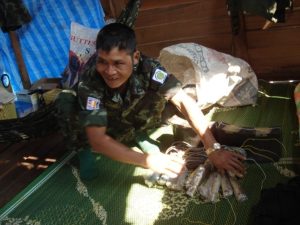Reported by Saing Nondel and Lita Davidson
Wed, Dec 30, 2009
In early April this year, the International Campaign to Ban Landmines (ICBL) held a meeting in Bangkok, Thailand on reducing landmine use under the banner of Achieving a Mine-Free Southeast Asia. Representatives from 17 countries attended with three from the Burmese government for the very first time.
U Kyaw Tint Swe from Myanmar Foreign Ministry Department who attended the meeting accused the Karen National Union (KNU), an ethnic arm group, for using landmines, while denying their use by his government’s military forces who indiscriminating use the weapon in conflict zones and civilian areas. As a member of the Conference on Disarmament, the Myanmar junta continues to justify their use for the security of the nation. The production of landmines and their use in Myanmar have continued since the Ottawa Treaty was first implemented in 1999 and since 2005 when the Myanmar government made its first public statement on a landmine ban the number of causalities has increased significantly according to yearly figures gathered by the Land Monitor Team. In 2007 “the (Myanmar) Military Heavy Industries reportedly began recruiting technicians for the production of the next generation of mines and other munitions” while its allies “the United Wa State Army was allegedly producing PMN-type antipersonnel mines.” In the (2009) Land Monitor Report “the Myanmar Defense Products Industries (Ka Pa Sa), a state enterprise at Ngyaung Chay Dauk in western Pegu, (has produced) fragmentation, blast, and non-detectable antipersonnel landmines,” meanwhile “the authorities do not provide any information on the types and quantities of stockpiled antipersonnel mines.”

From 2004 to 2008 the number of causalities has jumped from 132 in 2004 to 721 in 2008, which could be due to the improved data collection methods. But while the higher rate of casualties reflects the true scope of the problem, reports indicate an increasing use of landmines by both the government and insurgent forces. In a society suffering from a complete lack of democratic rights and a communication breakdown, the military continues to justify landmines and uses whatever means to enforce its rule over the ethnic populations to root out opposition while terrorizing the local people by launching offensives in several villages in Karen State and in Bago Division. After destroying crops and burning down villages their protocol is to lay landmines to prevent the local people from moving back into their homes. The SPDC also plants landmines indiscriminately not only in zones of conflict but in the urban areas to keep out the civilian population such as around the perimeter of its new hydropower plants in Toungoo Division on the Sittaung River and in areas near their new capital Pyinmana to keep out unwanted visitors.

The armed culture in Burma determines how landmines are used. Each side tries to break down their opponents’ control and justifies their use for offensive and defensive purposes: the military government is engaged in a struggle to impose order in the country and to root out those who threaten it while their enemies use whatever it takes to protect their people against the regime, one villager, Saw Soe Lay, sums up the situation clearly: “If we don’t use landmines it is not possible for us to do anything. We use them, but we always let the villagers know. But (SPDC) soldiers use landmines and they don’t let the villagers know so landmines hurt many villagers. Burmese people caught in the conflict zones, landmines are a deadly part of their daily life.” While the landmine treaty firmly takes hold throughout the world and whose continued use becomes widely stigmatized within the last year over 1,200 people were killed with 3,800 being seriously injured including many civilians. Only two countries, Myanmar and Russia, have planted landmines since 2008. There are thirteen countries that have abstained from joining the treaty and continue to stockpile, produce and lay landmines since 1999 including, Myanmar, Russia, China, India, Pakistan and United States of America. The United States Bush Administration announced its policy on the weapon in February 2004: “The United States will not join the Ottawa Convention because its terms would have required us to give up a needed military capability.” But while the US has halted from using landmines since the Gulf War in 1991, it has stockpiles of over ten million landmines including the M-14 type, some of which are stockpiled at the US bases in South Korea for use in any future war with North Korea and which have found their way into the conflict zones of Burma, according to the 2006 report. The use of the US M-14 by the Myanmar Army has increased with many being “placed on the main trails in the mountains in southern Karenni state and northern Karen state.” Many other types of mines are also planted in areas where civilians go about their daily business such as along footpaths, around the perimeters of schools and villages, and along the borders areas including the refugee camps.
Recently there has been increasing hope at the international level to finally address the horrendous human rights situation in Burma. Mr. Paulo Sergio Pinheiro, the former United Nations Special Rapporteur on Human Rights in Myanmar, who worked eight years with the UN, recently published an article titled “End Burma’s System of Impunity’ in the New York Times to alert the UN Security Council that it needs to set up an Investigating Commission to take action and investigate the crimes committed by the Burmese government. In order to prove that the military has committed these crimes and which continues to do so with impunity, members of parliament from 29 countries submitted to the UN Security Council a petition to urge the United Nations to pass a resolution setting up an inquiry into human rights violations and imposing a global arms embargo on the military junta, according to recent news reports. More than 420 members of parliament from 29 countries petitioned the Security Council on International Human Rights Day on 10th December, 2009.
Without stronger international support to address the Burmese government’s impunity to commit war crimes against its own people, the civil war will continue to dismantle the economy and further deny the many millions of young people their education and proper health services, and the military government and the ethnic arm groups will continue to kill each other for protection and security. Armed conflict has become a normal part of life with men expressing their identity as soldiers in a country that has seen over a half century of it and which has become a glaring testimony of a government’s inability to govern. The breakdown of Burma’s society will continue to unfold as before with children being pushed into armed combat, young girls being raped as sex slaves, villages being destroyed and productive farmland being turned into military battalions, while villagers are either persecuted or forced to live as Internally Displaced Persons with many more fleeing to neighboring countries.














